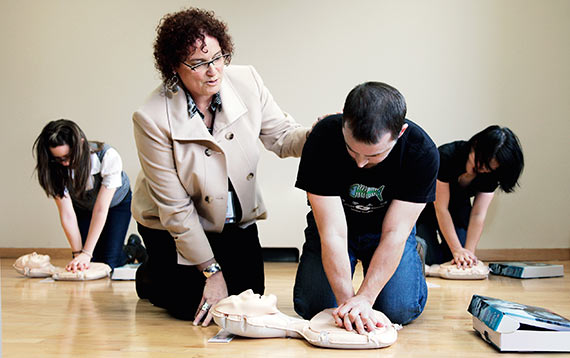PS News presents reports on recent College activities and a selection of announcements, events and initiatives in the wider education community that may be of interest to our members.
Saving lives
Grade 9 students learn CPR, the video way
Can Grade 9 students save lives? You bet, according to the managers of a cardiopulmonary resuscitation (CPR) pilot project being tested among 320 students in six Greater Toronto Area schools. “This is an excellent age to introduce teens to CPR,” says Blake Hurst, research co-ordinator for CPR Anytime, Any School.
Supporters of the study, which include Toronto’s St. Michael’s Hospital and the University of Toronto’s Faculty of Medicine, want to save lives through pre-hospital intervention. Specifically, they want to increase the rate of bystander CPR assistance for people experiencing heart attacks outside of hospitals.
When compared to other North American cities, Toronto has a poor survival rate for people suffering out-of-hospital cardiac arrests. Just 5.5 per cent survive, compared to 16.3 per cent in Seattle. “The difference is because of our poor bystander assistance,” says Hurst. “Hundreds of lives could be saved.”
Adds Laurie Morrison, a global leader in out-of-hospital emergency care and an emergency physician at St. Michael’s, “Canada’s bystander CPR rate is abysmal. There’s no good reason not to learn how to do CPR.”
Morrison is director of Rescu, an Ontario research group dedicated to outside-hospital emergency care. The American Heart Association and a Norwegian foundation gave Rescu a $50,000 grant for the Grade 9 video-based, self-directed program. Each student receives a DVD and a mannequin upon which to practise CPR techniques.
The CPR component of the program can be completed in 22 minutes, compared to the three to four hours it takes in a classroom. Since the students follow a trained instructor’s video instructions, CPR Anytime, Any School does not require CPR-qualified staff on site.
Although CPR instruction is required, many schools are unable to deliver it properly because of time and professional-resource constraints. If successful, the pilot project would “lower the barriers to delivering CPR instruction in all schools,” Hurst says.
A similar self-directed program has been tested on adults with great success, and the hope is to replicate those results with the Grade 9 students. In April, program organizers will return to the schools they visited in November – two private in Toronto and four public in Halton Region – to assess retention levels among participants.
Says Hurst, “If we get kids thinking about and capable of doing CPR at that age, they will take the knowledge with them later in life. Bystander participant rates should increase, and that means survival rates will as well.”
For more information contact Laurie Morrison at morrisonl@smh.ca.

Life-saving teens: Emergency physician Laurie Morrison provides a hands-on CPR demonstration for a Grade 9 student involved in the Greater Toronto Area self-directed video-based pilot program.